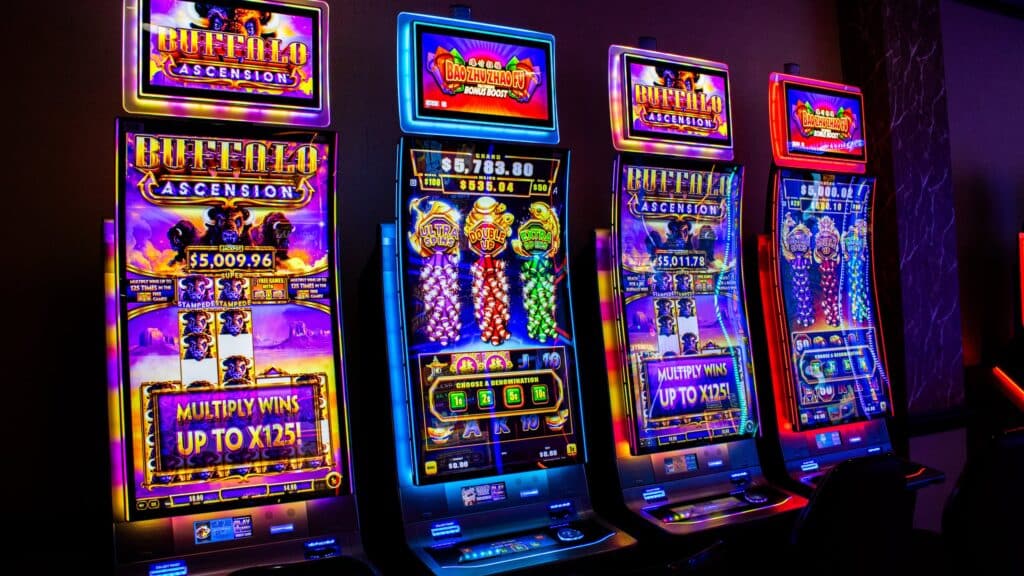Understanding game volatility is crucial for developing effective slot strategies, as it significantly shapes your gambling experience and the potential outcomes in online and land-based casinos.
Decoding Slot Volatility: A Comprehensive Guide for Savvy Gamblers
In the dynamic world of slot machines, game volatility stands as a cornerstone concept that every player, from novice to veteran, should grasp to refine their gameplay and strategy. Often referred to as variance, volatility in slots dictates the risk level associated with a particular game, influencing both the frequency and size of payouts. Understanding volatility is not just about knowing how often you might win, but also about aligning your gambling style and bankroll with the inherent risk of the slot game you choose. This detailed exploration aims to dissect the intricacies of slot volatility, its profound impact on gameplay, and how you can strategically leverage this knowledge to enhance your slot experience.
What is Slot Volatility?
Slot volatility, or variance, is a measure of the risk involved in playing a particular slot game. It essentially describes how the game distributes payouts over time. In simpler terms, volatility tells you how often and how much you can expect to win while playing a slot. It’s important to note that volatility is different from the Return to Player (RTP) percentage. RTP is a theoretical calculation of how much of all wagered money a slot machine will pay back to players over time, usually expressed as a percentage. Volatility, on the other hand, is about the pattern of these payouts – are they frequent and small, or infrequent but large?
Volatility is typically categorized into three main levels: low, medium, and high, each offering a distinct gaming experience.
Low Volatility Slots
Low volatility slots are characterized by frequent, but typically smaller, wins. These games are designed to provide a steady stream of payouts, keeping your bankroll relatively stable over time. The thrill in low volatility slots comes from the consistency of winning rather than the anticipation of a life-changing jackpot. These slots are often recommended for:
- Beginner gamblers: New players can enjoy a less risky environment, allowing them to extend their playtime and understand slot mechanics without significant bankroll depletion.
- Players with smaller bankrolls: The lower risk factor means you can play for longer periods with a limited budget, maximizing entertainment value.
- Those who prefer longer playing sessions: If your goal is to stretch your gambling session and enjoy consistent, albeit smaller, wins, low volatility slots are ideal.
- Risk-averse players: If you are uncomfortable with significant fluctuations in your bankroll and prefer a more predictable gaming experience, these slots offer a safer option.
Examples of low volatility slots often include classic fruit machines and some video slots with simpler bonus features. Payouts tend to be more evenly distributed, with less dramatic swings in your balance.
Medium Volatility Slots
Medium volatility slots strike a balance between the frequency and size of payouts. They offer a mix of smaller, more frequent wins and the occasional larger payout. These games are versatile and appeal to a broader range of players, providing a moderate level of risk and reward. Medium volatility slots are suitable for:
- Players seeking a balance: If you want a mix of frequent wins and the chance for a substantial payout, medium volatility slots offer a good compromise.
- Players with mid-sized bankrolls: These games can accommodate a moderate bankroll, providing a decent playtime without excessive risk.
- Those who enjoy varied gameplay: Medium volatility slots often come with a range of features and bonus rounds, providing engaging and diverse gaming sessions.
Many popular video slots fall into the medium volatility category, offering a blend of base game wins and bonus feature payouts. These games cater to players who want more excitement than low volatility slots but are not ready for the high risk of high volatility games.
High Volatility Slots
High volatility slots are the riskiest but potentially most rewarding. They are characterized by infrequent wins, but when they do hit, the payouts can be substantial, sometimes even life-changing. These slots are designed for players who are chasing big wins and are comfortable with periods of losses. High volatility slots are best suited for:
- Experienced gamblers: Players who understand the risks and rewards of slot volatility and have developed strategies to manage high variance gameplay.
- Players with larger bankrolls: A significant bankroll is necessary to withstand the dry spells and prolonged periods without significant wins common in high volatility slots.
- "High roller" or risk-seeking players: If you are drawn to the thrill of chasing large jackpots and can handle the inherent risk, high volatility slots can provide an exhilarating experience.
- Players aiming for large payouts: If your primary goal is to win big, and you are less concerned about frequent small wins, high volatility slots are your target.
Progressive jackpot slots are often high volatility, as are many modern video slots with complex bonus features and large multipliers. These games can offer massive payouts, but require patience and a bankroll capable of enduring extended losing streaks.
Impact of Volatility on Slot Strategy
Understanding slot volatility is not just academic knowledge; it's a practical tool that significantly impacts how you should approach playing slots. Your choice of slot volatility should be a strategic decision aligned with your gambling goals, risk tolerance, and bankroll size.
Bankroll Management and Volatility
Bankroll management is paramount when playing slots, and it is inextricably linked to game volatility. The level of volatility you choose should directly influence how you manage your funds.
- Low Volatility: With low volatility slots, your bankroll is likely to experience less fluctuation. You can typically play for longer periods with a smaller bankroll. A conservative bankroll management approach might involve betting a smaller percentage of your total bankroll per spin, as the risk of rapid depletion is lower.
- Medium Volatility: Medium volatility slots require a more balanced approach to bankroll management. You need a bankroll that can withstand some fluctuations, but you don't need to be as heavily capitalized as for high volatility games. A moderate betting strategy, adjusting bet sizes based on your session's performance, can be effective.
- High Volatility: High volatility slots demand robust bankroll management. Due to the potential for extended losing streaks, you need a larger bankroll to weather the variance and increase your chances of hitting a significant win. Aggressive bankroll management, such as setting strict loss limits and being prepared to end a session early, is crucial. It is often recommended to bet a smaller percentage of your bankroll per spin to extend playtime and increase the odds of eventually hitting a large payout.
Failing to adjust your bankroll management to the volatility of the slot game is a common mistake. Playing high volatility slots with a small bankroll can lead to quick losses and a frustrating experience. Conversely, playing low volatility slots with a very large bankroll might not provide the excitement or potential for significant wins that some players seek.
Bet Sizing Strategies Based on Volatility
Your bet size should also be strategically adjusted based on the volatility of the slot game you are playing. A one-size-fits-all betting approach is not optimal in slot gambling.
- Low Volatility: In low volatility slots, you might consider slightly increasing your bet size relative to your bankroll, as the risk of rapid losses is lower. This can help maximize smaller wins and potentially speed up reaching any bonus features. However, always stay within your comfortable betting limits.
- Medium Volatility: For medium volatility slots, a moderate and consistent bet size is generally recommended. You can adjust your bets based on your session's progress, perhaps increasing slightly after a series of wins or decreasing after losses, but avoid drastic changes.
- High Volatility: With high volatility slots, it is often advisable to keep your bet size relatively small compared to your bankroll. This strategy helps to prolong your playtime, giving you more opportunities to trigger the less frequent but larger payouts. While it might be tempting to increase bets after losses to recover funds, this can be risky in high volatility games and should be approached with caution.
The key is to find a bet size that allows you to enjoy a reasonable number of spins while aligning with the game's volatility and your bankroll capacity. Remember, responsible gambling involves making informed betting decisions, not chasing losses or betting beyond your means.
Volatility and Playing Style
Slot volatility should also be considered in relation to your personal playing style and gambling preferences. Different players seek different experiences from slot games, and volatility plays a key role in shaping these experiences.
- Entertainment-Focused Players: If you primarily gamble for entertainment and enjoyment, low to medium volatility slots might be more suitable. They provide more frequent wins, which can be psychologically rewarding and extend your playtime, enhancing the entertainment value.
- Profit-Oriented Players: Players who are more focused on potential profits and are willing to take on higher risk might gravitate towards high volatility slots. The allure of large payouts, even if infrequent, can be a significant draw for those seeking substantial wins. However, it’s crucial to remember that high volatility also means higher risk of losses.
- Bonus Feature Enthusiasts: Many modern video slots are designed with intricate bonus features. High volatility slots often concentrate larger payouts within these bonus rounds, making the base game less rewarding but the bonus features potentially very lucrative. Players who enjoy the excitement of bonus features and are patient enough to wait for them might prefer high volatility games.
Understanding your own gambling style is crucial in choosing the right volatility level. Are you looking for consistent engagement and longer playtime, or are you chasing the thrill of a big win and willing to accept more risk? Your answer to this question should guide your slot selection.
Identifying Slot Volatility
Unfortunately, slot volatility is not always explicitly stated by game developers or casinos. However, there are several methods players can use to estimate the volatility of a slot game.
- Paytable Analysis: Examining the paytable can offer clues about volatility. High volatility slots often have a significant difference between the top payouts and lower-tier payouts. Low volatility slots tend to have more evenly distributed payouts across the paytable. Look for the ratio between the highest and lowest payouts; a larger ratio may indicate higher volatility.
- Bonus Features: The type and frequency of bonus features can be indicative of volatility. High volatility slots may have bonus features that are harder to trigger but offer substantial rewards, such as large multipliers or progressive jackpots. Low volatility slots might have more frequent but less lucrative bonus rounds.
- Gameplay Experience (Demo Play): Playing a slot in demo mode can provide a feel for its volatility. Observe the frequency and size of wins during a demo session. While demo play cannot guarantee future outcomes in real money play, it can offer a general sense of the game's payout pattern.
- Online Slot Reviews and Communities: Many online resources, such as slot review sites and gambling forums, discuss slot volatility. Player reviews and expert analyses often provide insights into the perceived volatility of specific games based on real gameplay experiences. Be sure to consult reputable sources and consider multiple opinions.
- Betting Range: Sometimes, the betting range of a slot can be an indirect indicator. High volatility slots may cater to high rollers with wider betting ranges, while low volatility slots might have narrower ranges suitable for players with smaller budgets.
It’s important to use a combination of these methods to get a more accurate estimation of a slot's volatility. No single method is foolproof, but together they can provide a reasonable understanding of the risk level involved.
Psychological Aspects of Volatility
Slot volatility not only affects your bankroll and strategy but also has a significant psychological impact on your gambling experience. Understanding these psychological aspects can help you manage your emotions and make more rational gambling decisions.
- Emotional Rollercoaster: High volatility slots can be an emotional rollercoaster. The long periods without significant wins can be frustrating and may lead to impatience or chasing losses. However, the occasional large win can trigger intense excitement and euphoria. Players need to be emotionally prepared for these swings.
- Patience and Perseverance: Playing high volatility slots requires patience and perseverance. Wins are infrequent, and you need to be mentally prepared to endure losing streaks. Players who are easily discouraged by losses might find high volatility games stressful.
- Sense of Achievement: When a large win finally hits in a high volatility slot, it can create a strong sense of achievement and validation, reinforcing the risk-taking behavior. This psychological reward is part of the appeal for players who prefer high volatility.
- Consistent Engagement: Low volatility slots, with their frequent wins, can provide a more consistent sense of engagement and positive reinforcement. The steady stream of smaller wins can be psychologically satisfying for players who prefer a more predictable and less emotionally intense gambling experience.
- Risk Perception: Different people have different perceptions of risk. Some gamblers are comfortable with high risk for the potential of high reward, while others prefer lower risk and more consistent outcomes. Understanding your own risk tolerance is crucial in choosing the right volatility level and managing your gambling expectations.
Being aware of the psychological impact of volatility is as important as understanding the mathematical aspects. It helps you to gamble responsibly, manage your emotions, and choose games that align with your psychological profile and gambling goals.
Examples of Slots and Their Volatility
To further illustrate the concept of slot volatility, let’s consider some examples of popular slot games and their typical volatility levels. Please note that volatility assessments can sometimes be subjective and may vary based on different sources and player experiences.
- Low Volatility Examples:
- Starburst (NetEnt): A classic and widely popular slot known for its frequent, smaller wins and straightforward gameplay. It's often cited as a prime example of a low volatility slot.
- Blood Suckers (NetEnt): Another NetEnt title, Blood Suckers is praised for its high RTP and low volatility, making it a favorite for players looking to stretch their bankroll.
- Book of Dead (Play'n GO): Despite its popularity, Book of Dead is generally considered a high volatility slot.
- Medium Volatility Examples:
- Gonzo's Quest (NetEnt): Gonzo's Quest offers a good balance of risk and reward, with decent base game wins and engaging bonus features, placing it in the medium volatility category.
- Thunderstruck II (Microgaming): A popular slot with multiple bonus rounds, Thunderstruck II is often categorized as medium volatility, offering a mix of win frequencies and sizes.
- Bonanza (Big Time Gaming): While some consider Bonanza to be on the higher end of medium volatility, it generally falls into this category due to its balanced gameplay and potential for significant wins in the bonus feature.
- High Volatility Examples:
- Book of Dead (Play'n GO): Book of Dead is widely recognized as a high volatility slot. While wins in the base game can be sparse, the free spins feature has the potential for very large payouts.
- Dead or Alive 2 (NetEnt): Dead or Alive 2 is notorious for its extreme volatility. Base game wins are infrequent, but the bonus features, especially the "High Noon Saloon" free spins, can deliver massive payouts.
- Raging Rhino (WMS): Raging Rhino is another high volatility slot known for its potential for huge wins in the free spins bonus, but also for long periods of low returns in the base game.
These examples are for illustrative purposes, and volatility can sometimes be perceived differently by individual players. Always conduct your own research and, if possible, try demo versions to get a feel for a slot's volatility before playing with real money.
Conclusion: Volatility as a Key Strategic Element
Game volatility is more than just a technical characteristic of slot machines; it is a fundamental element that shapes your entire gambling experience. By understanding slot volatility and its implications, you can move beyond simply spinning the reels and develop a strategic approach to slot gambling. Choosing slots based on their volatility level, aligned with your bankroll, risk tolerance, and gambling goals, is a hallmark of a savvy and responsible gambler. Whether you prefer the steady engagement of low volatility slots, the balanced gameplay of medium volatility games, or the thrilling chase for big wins in high volatility slots, understanding volatility empowers you to make informed decisions and enhance your overall slot playing experience. Remember, responsible gambling always starts with knowledge and informed choices.
External Resources:



